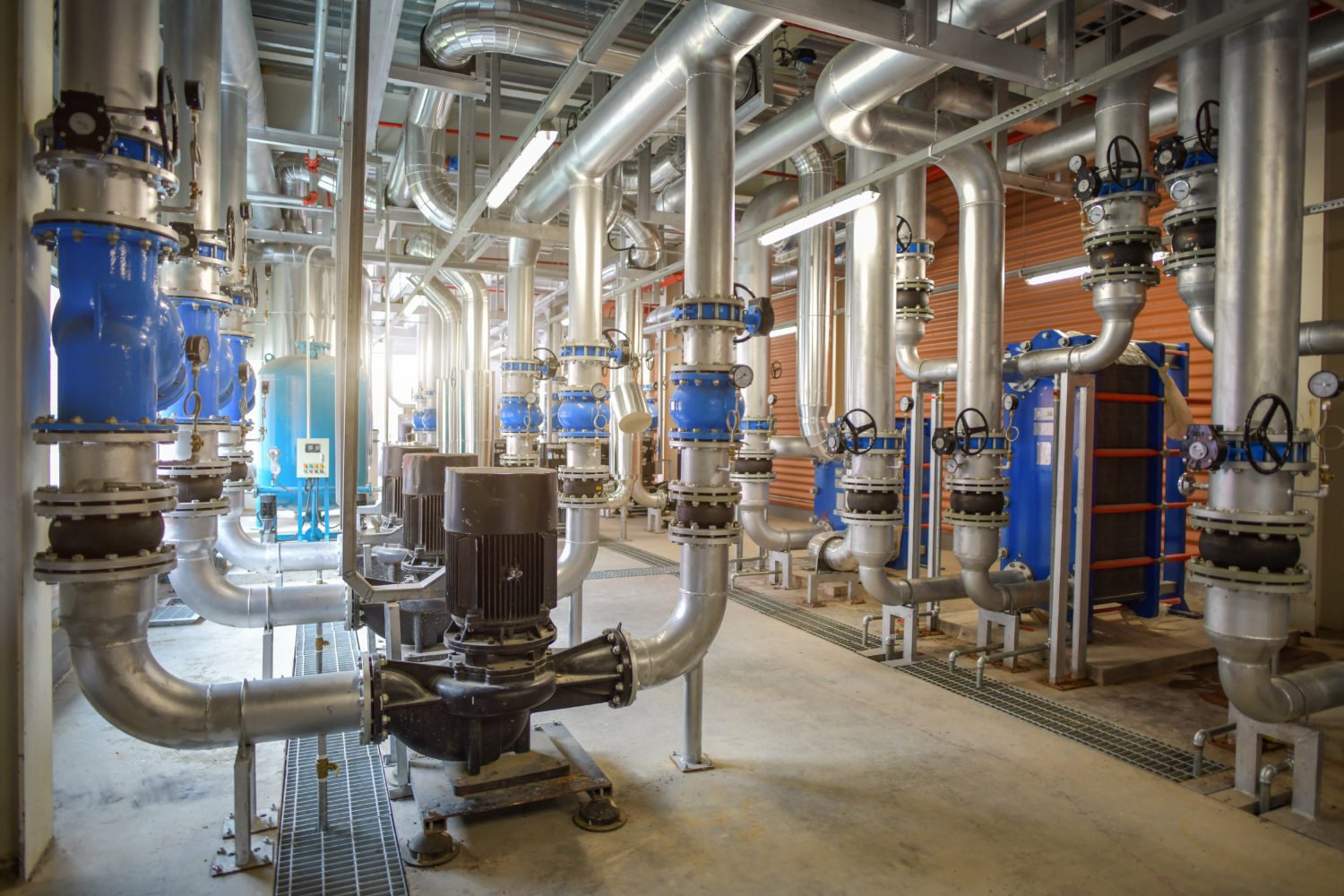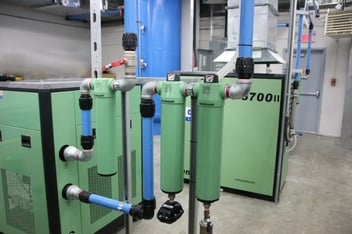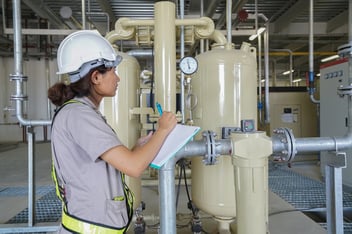4 Types of Industrial Vacuum Pumps

Industrial vacuum pumps are an essential component of any vacuum system. And while all vacuum pumps function to complete the same task, there are a number of technologies, classifications, and capabilities that get them there. This can make choosing a vacuum pump for your system a tricky business. If you’re trying to get a handle on the technology behind all of the vacuum pumps available to your system, this article should help.
We’re going to define the basic function of an industrial vacuum pump and offer some insights into four of the industrial vacuum types most commonly used in industrial applications. Let’s start with an overview of what industrial vacuum pumps do.
What does an Industrial Vacuum Pump Do?
All industrial vacuum pumps perform the same function — vacuum pumps work to remove air molecules and other gases from a vacuum chamber. As the vacuum pump removes those molecules, the pressure in the chamber changes, making it more and more difficult to entirely remove all of the molecules within the vacuum chamber. This is where your complete vacuum system comes in — it must be able to operate across a massive pressure range, spanning from 1 to 10-6 Torr of pressure. To accomplish this, your vacuum system uses several different styles and technologies in series to remove air molecules at each specific pressure range.
What are the Pressure Ranges of an Industrial Vacuum System?
As mentioned above, any industrial vacuum system employs a few vacuum pumps to continue to remove air and gas molecules as pressure ranges change. Most industrial vacuum systems must address the following pressure ranges:
- Rough/Low Vacuum: 1000 to 1 mbar / 760 to 0.75 Torr
- Fine/ Medium Vacuum: 1 to 10-3 mbar / 0.75 to 7.5-3 Torr
- High Vacuum: 10-3 to 10-7 mbar / 7.5-3 to 7.5-7 Torr
- Ultra-High Vacuum: 10-7 to 10-11 mbar / 7.5-7 to 7.5-11 Torr
- Extreme High Vacuum: < 10-11 mbar / < 7.5-11 Torr
Each of these ranges corresponds to a different vacuum pump in the system’s series:
- Primary or backing pumps function in rough and low vacuum pressure ranges
- Booster pumps perform in rough and low vacuum pressure ranges
- Secondary or high vacuum pumps function in high, very high, and ultra-high vacuum pressure ranges
Two Main Categories of Industrial Vacuum Pumps: Wet and Dry
Before we jump into the different types of pumps used in an industrial vacuum system, it’s important to understand that vacuum pumps are available in two main categories — wet and dry. Similar to oil and oil-free air compressors, wet and dry industrial vacuums differ depending on whether the air or gas they are removing is exposed to oil or water during the compression process.
Wet vacuum pumps use oil or water for lubrication or sealing. While wet vacuum pumps are a long-lasting and low maintenance option, this lubrication fluid can contaminate the air that’s pumped (or swept) from the chamber. This is typically fine for a number of manufacturing applications, but for those where air quality is critical, like food production or packaging, dry vacuum pumps are the better option.
Dry vacuum pumps reduce the risk of system contamination and oil disposal. These pumps may use oil or grease in the gears or bearings but rely on tightly sealed clearances between the rotating and static parts of the pump to ensure that no fluid is present in the swept air or gas.
4 Types of Industrial Vacuum Pumps
There is a wealth of industrial vacuum pump products on the market, each with a specific application, but most industrial vacuum pumps fall into one of four main types: gas transfer, positive displacement, kinetic, and entrapment. Here’s a simple overview of how each type of industrial vacuum pump works.
01. Gas Transfer Vacuum Pumps
A gas transfer vacuum pump is any type of vacuum pump that transfers air or gas molecules by momentum exchange or positive displacement. In these types of vacuum pumps, the same number of molecules that enter a pump, leave the pump, though they are slightly compressed. Both kinetic and positive displacement vacuum pumps are types of gas transfer vacuum pumps.
02. Positive Displacement Vacuum Pumps
Technically, positive displacement vacuum pumps are a sub-type of gas transfer vacuum pumps. They work by trapping a volume of gas mechanically and moving it through the pump. Positive displacement vacuum pumps are some of the most commonly used types and are employed in multiple stages of a vacuum system.
Common types of positive displacement vacuum pumps:
- Oil Sealed Rotary Vane Pump (Wet)
- Liquid Ring Pump (Wet)
- Diaphragm Pump (Dry)
- Scroll Pump (Dry)
- Roots Pump (Dry)
- Claw Pump (Dry)
- Screw Pump (Dry)
03. Kinetic Vacuum Pumps
Kinetic, or kinetic transfer pumps, use momentum transfer to direct gas towards the pump outlet. These vacuum pumps use either high-speed blades or an introduced vapor to direct gas towards the outlet. Kinetic vacuum pumps are unique in their ability to achieve high compression ratios at low pressures, but they typically don’t have sealed volumes.
Common types of kinetic vacuum pumps:
- Turbomolecular Pumps (Dry)
- Vapor Diffusion Pumps (Wet)
04. Entrapment Vacuum Pumps
The fourth type of industrial vacuum pump is unique in that rather than transferring gas molecules, it captures them. Using cryogenic condensation, ionic reaction, or chemical reaction, capture pumps can provide extremely high vacuum, though they do operate at lower flow rates. Because most entrapment pumps use a reaction of some sort, they are able to successfully create an oil-free vacuum.
Common types of entrapment vacuum pumps:
- Cryopump (Dry)
- Sputter Ion Pumps (Dry)
While these are the four most common types of industrial vacuum pumps, you can see from the information in this article that there is a vast range of vacuum pumps available on the market. Most industrial applications employ a range of vacuum pump types within their larger vacuum system, which is why it’s always good to consult with an air system expert if you have any questions about your compressed air or vacuum system.
If you’re having trouble determining what vacuum pump is right for your application, TMI can help. As air experts, we handle everything from air compressors to blowers, to industrial vacuum pumps. Whether you’re looking for a replacement part, a new vacuum pump, or an updated vacuum system, we can help you find what you’re looking for. Give us a call at 800-875-9555 or contact us online today.
Contact TMI Air Compressors


